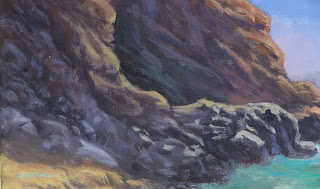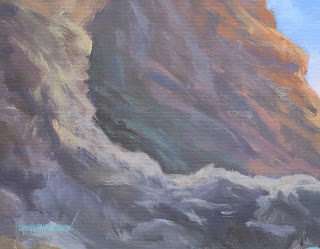While we didn't get the project completely done in class, you should have enough information to finish the project up the way you want.If you feel you are done then don't fuss with it, better if it is a bit under worked rather than over worked.
The following are a few things that we did in class as part of the finishing process:
 Under painting the foam. Whenever you have something that is white you need to under paint it with a darker color, usually blues and lavenders, because it won't look white ir light without the contrast of values - white on white is a polar bear in a snow storm, it will just look flat and lifeless. I under painted my foam with a light blue violet using my gesso for white, a touch of blue, purple and a bit of mud from my palette to create a soft grayed color. Remember to follow the shape of what you are painting so if the foam is suppose to be flat, so will your strokes, if it is a crashing wave it will be a series of circular strokes.
Under painting the foam. Whenever you have something that is white you need to under paint it with a darker color, usually blues and lavenders, because it won't look white ir light without the contrast of values - white on white is a polar bear in a snow storm, it will just look flat and lifeless. I under painted my foam with a light blue violet using my gesso for white, a touch of blue, purple and a bit of mud from my palette to create a soft grayed color. Remember to follow the shape of what you are painting so if the foam is suppose to be flat, so will your strokes, if it is a crashing wave it will be a series of circular strokes.
The highlight for the foam is not white straight out of the tube because white can look chalky unless you mix it with something else like a tiny touch of yellow or orange. A word of caution here: both of these colors will be stronger than you think so take what you think is a tiny amount of color, cut it in half then use half of that particularly the orange, you just want to tint the white to warm it a bit. Add this light color just to the tops of the foam, leave some of the under painting it will give your foam depth.
Making sand. If you want to give your sand and rocks more texture you can use your toothbrush and splatter color into the areas where you want it to look like little rocks and pebbles. Use all the colors on your palette and splatter lightly. Let it dry before highlighting a few of the larger dots. It's just quick touches, don't fuss with it.
Also get the bigger rocks under painted and highlighted, again it is best to work this quickly just making various sized strokes like upside down "U's". This is a mass of rocks so you won't be seeing individual rocks more like areas of texture, so paint it as an area not as individual rocks.
Highlighting the wet rocks. You can use the same highlight color that you used on the foam, just don't do what I did and put too much on. These are just supposed to be little sparkles on the wet rocks so you might need to get out a smaller brush. I am going to have to go back in and add dark until I get what I am looking for but that is part of the process: If you don't like it, paint it out! don't be afraid of making adjustments as you are finishing up your painting.
Each of you will finish your paintings different from each other and different from mine and that is a good thing. I am here to teach you how to use the paint and the equipment so that you as an artist can develop your own style. Don't be afraid to experiment with brushes, colors, palette knives or styles. This is your painting and you need to own it and as you do you will find that painting becomes a lot more fun.
Keep painting and I will see you in the next class.












